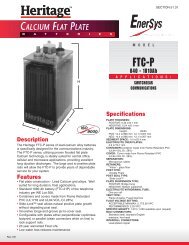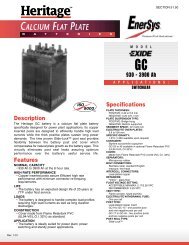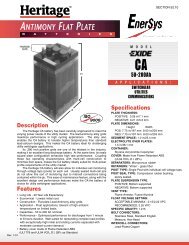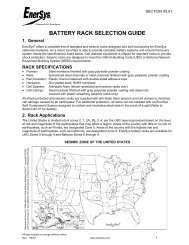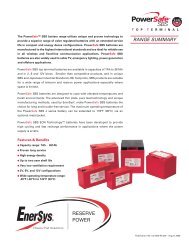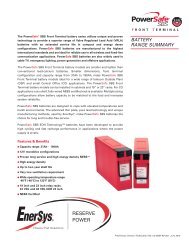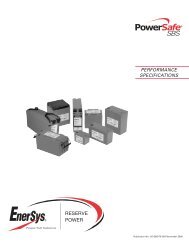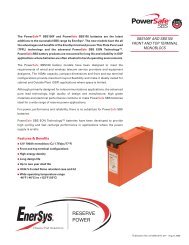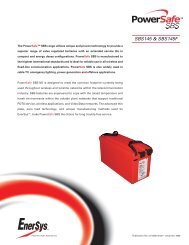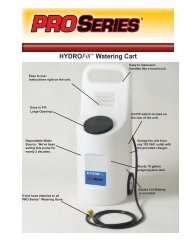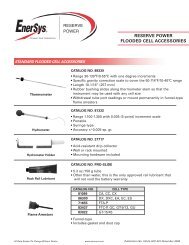PowerSafe V Product Guide new - EnerSys
PowerSafe V Product Guide new - EnerSys
PowerSafe V Product Guide new - EnerSys
You also want an ePaper? Increase the reach of your titles
YUMPU automatically turns print PDFs into web optimized ePapers that Google loves.
Installation<br />
Warning<br />
SBS monoblocs are supplied in a charged condition, and are<br />
capable of extremely high short circuit currents. Take care to<br />
avoid short-circuiting terminals of opposite polarity.<br />
Unpacking<br />
Open the shipping containers and check the contents for<br />
damage and against the packing list. Immediately inform the<br />
Enersys sales department of any damaged or missing items.<br />
Battery Location<br />
Batteries can be installed on racks, shelves or in cabinets.<br />
The floor must be capable of supporting the combined weight of<br />
the battery, housing, accessories and cables.<br />
Monobloc Connection<br />
Each battery is supplied with an instruction sheet or manual.<br />
The positive terminal on each monobloc is identified by a<br />
“+” sign and/or a red collar round the terminal. Install the<br />
monoblocs in accordance with the instructions and layout<br />
drawing. Check that the correct terminal orientation and<br />
positive/negative polarity sequence is maintained throughout<br />
the battery string.<br />
Connect the blocs together with the connectors and<br />
fasteners provided. The fastener torque values are:<br />
Model(s) Fastener Torque<br />
SBS8 M4 1.0 Nm / 9 in lbs<br />
SBS15– 60 M6 3.9 Nm / 35 in lbs<br />
SBS110–390 M8 5.0 Nm / 44 in lbs<br />
SBS J13–70 M6 6.8 Nm / 60 in lbs<br />
SBSB8–14 M8 5 Nm / 44 in lbs<br />
SBSC11 M8 5 Nm / 44 in lbs<br />
Place the insulating covers in position immediately after<br />
tightening the fasteners.<br />
The main battery cables are now ready to be connected to<br />
the system.<br />
www.enersysinc.com<br />
Site Acceptance Tests<br />
Before conducting a capacity discharge or fully loaded duty<br />
cycle test the battery must be given a commissioning charge.<br />
The commissioning charge shall consist of 7 continuous days<br />
of float charge at the recommended float voltage with no<br />
load connected to the battery, see Charging, page 19.<br />
Ventilation<br />
During normal charging conditions the volume of hydrogen<br />
emitted from a SBS battery is virtually negligible, and will<br />
normally dissipate rapidly into the atmosphere. To comply with<br />
the requirements of EN 50272, Part 2, the battery room, or<br />
cabinet must have sufficient air circulation to limit the<br />
accumulation of hydrogen gas to a maximum of 1% by volume,<br />
when the battery is being charged at the equivalent of 2.40<br />
volts per cell.<br />
Optional remote venting systems are available to vent gases<br />
outside the battery compartment.<br />
SBS typical hydrogen evolution rates on stabilised float at<br />
25°C/77°F are:<br />
Hydrogen Evolution = ml/hour/bloc<br />
Volts/Cell 2.27 Vpc 2.40 Vpc 2.45 Vpc<br />
SBS8 0.7 3.6 6.9<br />
SBS15 1.4 7.3 14<br />
SBS30 2.4 13 24<br />
SBS40 3.3 18 33<br />
SBS60 4.2 22 43<br />
SBS110 2.7 15 28<br />
SBS130 3.3 18 33<br />
SBS300 1.1 12 23<br />
SBS390 2.2 15 29<br />
SBS J13 1.1 5.8 11.1<br />
SBS J16 1.4 7.2 14.1<br />
SBS J30 2.6 13.3 26.3<br />
SBS J40 3.8 20.1 38.4<br />
SBS J70 5.9 31.3 59.6<br />
SBSB8 2.4 12.8 24.3<br />
SBSB10 3.0 15.9 30.3<br />
SBSB14 4.9 25.6 49.3<br />
SBSC11 5.6 29.6 56.2<br />
Publication No: EN-SBS-PG-001 February 2003<br />
17




